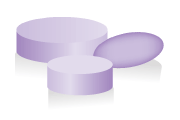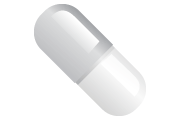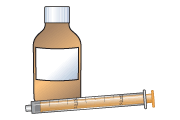Flecainide for abnormal heart rhythms
This leaflet is for parents and carers about how to use this medicine in children. Our information may differ from that provided by the manufacturers, because their information usually relates to adults. Read this leaflet carefully. Keep it somewhere safe so that you can read it again.
If your child has not eaten for more than 24 hours, for example if they have gastroenteritis (a tummy bug), contact your specialist doctor, as there is a chance of more serious side-effects from taking Flecainide. Your doctor may want to reduce the dose for a few days.
Name of medicine
Flecainide
Brand name: Tambocor
Why is it important for my child to take Flecainide?
Flecainide will help your child’s heart to beat at a normal rate and with a normal pattern (rhythm) so that it works properly to pump blood. It can be used for a range of arrhythmias including supraventricular tachycardia (sometimes called SVT), ventricular tachycardia, ventricular ectopic beats, Wolff–Parkinson–White syndrome and atrial fibrillation.
What is Flecainide available as?
- Tablets: 50 mg, 100 mg
- Capsules: 200 mg
- Liquid medicine: 25 mg in 5 mL
When should I give Flecainide
Flecainide is usually given two or three times a day. Your doctor will tell you how often to give it.
- Twice a day: this should be once in the morning and once in the evening. Ideally, these times are 10–12 hours apart, for example some time between 7 and 8 am and between 7 and 8 pm.
- Three times a day: this should be once in the morning, once in the early afternoon and once in the evening. Ideally, these times are at least 6 hours apart, for example 8 am, 2 pm and 8 pm.
Give the medicine at about the same time(s) each day so that this becomes part of your child’s daily routine, which will help you to remember.
How much should I give?
Your doctor will work out the amount of Flecainide (the dose) that is right for your child. The dose will be shown on the medicine label.
It is important that you follow your doctor’s instructions about how much to give.
How should I give Flecainide?

Tablets
- Tablets should be swallowed with a glass of water or juice, but not milk. Your child should not chew the tablet.

Capsules
- Capsules should be swallowed with a glass of water or juice, but not milk. Your child should not chew the capsule.

Liquid medicine
- The liquid medicine may make your child’s mouth feel numb for a short while. Give it at least an hour before or after food.
- Shake the medicine well.
- Measure out the right amount using an oral syringe or a medicine spoon. You can get these from your pharmacist. Do not use a kitchen teaspoon as it will not give the right amount.
Your child should not have milk, including breast milk, infant formula feed or dairy products (cheese, cream, yogurt) at the same time as Flecainide, as the medicine will not be absorbed from the stomach properly. You should allow at least one hour, preferably two hours, between feeding and giving Flecainide.
When should the medicine start working?
It may take a few days for Flecainide to have an effect. Continue to give Flecainide regularly during this time.
What if my child is sick (vomits)?
- If your child is sick less than 30 minutes after having a dose of Flecainide, give them the same dose again.
- If your child is sick more than 30 minutes after having a dose of Flecainide, do not give them another dose. Wait until the next normal dose.
If your child is sick again, seek advice from your family doctor, nurse, pharmacist, or hospital. They will decide what to do based on your child’s condition and the specific medicine involved.
What if I forget to give it?
If you usually give it twice a day: If you remember up to 4 hours after you should have given a dose, give your child the missed dose. For example, if you usually give a dose at about 7am, you can give the missed dose at any time up to 11am. If you remember after that time, do not give the missed dose. Give the next dose as usual.
If you usually give it three or four times a day: You do not need to give the missed dose. Give the next dose as normal.
Never give a double dose of Flecainide.
What if I give too much?
If you think you may have given your child too much Flecainide, contact your doctor or local NHS services (details at end of leaflet) or take your child to hospital. Have the medicine container or packaging with you, even if it is empty. This will be useful to the doctor.
It may be dangerous to give too much Flecainide.
Are there any possible side effects?
We use medicines to make our children better, but sometimes they have other effects that we don’t want (side effects).
Side effects you must do something about
If your child is short of breath or is wheezing, or their face, lips or tongue start to swell, or they develop a rash, they may be allergic to Flecainide. Take your child to hospital or phone for an ambulance straight away.
Very rarely, Flecainide can cause seizures (fits). If your child has a seizure, telephone for an ambulance. Do not restrain your child but try to make sure that they cannot hurt themselves (e.g. put a cushion under their head and move them away from furniture).
If your child’s heartbeat changes, starts to pound or beats faster (they may say their heart feels fluttery or is racing) or slower than usual, or if they have chest pain or become short of breath, call for an ambulance or take your child to hospital straight away. This may be a sign of a problem with the heart rate, which may need treatment.
If your child gets a yellowish tinge to the skin or whites of the eyes, or they have severe stomach pain or a high temperature (above 38°C), contact your doctor straight away, as there may be a problem with their liver
Your child may say that they see black spots or that their eyesight is blurred (fuzzy), or they see double. Contact you doctor if this happens.
Other side-effects you need to know about
Your child may have stomach pain, feel sick or be sick (vomit), feel bloated, have wind, diarrhoea or constipation (difficulty doing a poo) when they first start taking Flecainide. If these symptoms carry on for more than a week, contact your doctor.
Your child may feel dizzy or light-headed when they stand up, or may even faint. Encourage them to stand up slowly, and to sit or lie down if they feel dizzy or lightheaded.
Your child may be more tired than usual and may feel weak. They may also seem more forgetful. These effects should wear off. If they are still a problem after 2 weeks or if you are worried, contact your doctor.
Your child’s skin may become more sensitive to sunlight. Keep them out of strong sun. When outdoors, they should wear a long-sleeved top, trousers and a hat and should use a high-factor sun cream (at least SPF 30).
Your child may feel less hungry (lose their appetite). Encourage them to eat small meals often.
Your child’s skin may seem more sensitive and they may get a rash or itchiness. Try applying a moisturising cream or anti-itch cream. If this does not help, contact your doctor, in case your child is allergic to Flecainide.
There may sometimes be other side effects that are not listed above. If you notice anything unusual and are concerned, contact your doctor. You can report any suspected side effects to a UK safety scheme at mhra.gov.uk/yellowcard
Can other medicines be given at the same time as Flecainide?
- You can give your child medicines that contain paracetamol or ibuprofen, unless your doctor has told you not to.
- Flecainide should not be taken with some medicines. Tell your doctor or pharmacist about any other medicines your child is taking before giving Flecainide.
Check with your doctor or pharmacist before giving any other medicines to your child. This includes herbal and complementary medicines.
Is there anything else I need to know about this medicine?
- Flecainide liquid medicine has a local anaesthetic effect so your child’s mouth may feel numb for a while after taking it. They should not eat for about an hour after taking it, in case they bite their tongue.
- Your doctor may take blood samples to measure how much flecainide is in your child’s blood.
- If your daughter thinks that she may be pregnant, it is important that she sees your family doctor as soon as possible. She should keep taking her medicine until she sees her doctor.
General advice about medicines
- Only give this medicine to your child. Never give it to anyone else, even if their condition appears to be the same, as this could do harm.
- Make sure that you always have enough medicine. Order a new prescription at least 2 weeks before you will run out.
- Make sure that the medicines you have at home have not reached the ‘use by’ date on the packaging. Give old medicines to your pharmacist to dispose of.
- If you are not sure a medicine is working, contact your doctor but continue to give the medicine as usual in the meantime. Do not give extra doses, as you may do harm.
If you think someone else may have taken the medicine by accident, contact your doctor straight away.
Where should I keep this medicine?
- Keep the medicine in a cupboard, away from heat and direct sunlight.
- Make sure that children cannot see or reach the medicine.
- Keep the medicine in the container it came in.
- Liquid medicine should be stored at room temperature as it will precipitate (powder will form in the medicine) if it is put in the fridge.
Who to contact for more information?
Your doctor or pharmacist will be able to give you more information about Flecainide and about other medicines used to treat arrhythmias.
England: NHS 111
Tel 111
www.nhs.ukScotland: NHS 24
Tel 111
www.nhs24.scotNorthern Ireland: NI Direct
Wales: NHS 111 Wales
Tel 111
www.111.wales.nhs.ukArrhythmia Alliance
01789 867 501
www.heartrhythmalliance.org/aa/ukCopyright disclaimer
Version [1]. © NPPG, RCPCH and WellChild, all rights reserved. Review by November 2018.
The primary source for the information in this leaflet is the British National Formulary for Children. For details on any other sources used for this leaflet, please contact us through our website, www.medicinesforchildren.org.uk.
We take great care to make sure that the information in this leaflet is correct and up-to-date. However, medicines can be used in different ways for different patients. It is important that you ask the advice of your doctor or pharmacist if you are not sure about something. This leaflet is about the use of these medicines in the UK, and may not apply to other countries. The Royal College of Paediatrics and Child Health (RCPCH), the Neonatal and Paediatric Pharmacists Group (NPPG), WellChild and the contributors and editors cannot be held responsible for the accuracy of information, omissions of information, or any actions that may be taken as a consequence of reading this leaflet.
